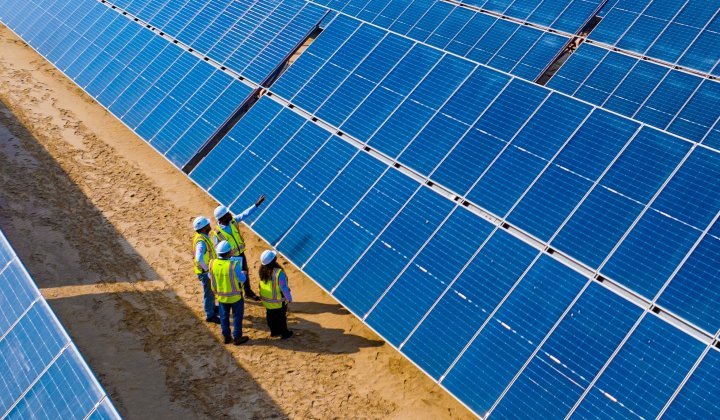A scientist by training, Rambharos began her career at Eskom straight out of university. She is currently the general manager of the utility’s Just Energy Transition in the office of the group chief executive.
Her earliest memory of working at Eskom was arriving at the power station where she was employed in an operational role as an environmental specialist, monitoring air quality, water, and waste. While she may have been one of the very few women on site, things have progressively improved over the years, and Eskom now employs numerous women in technical roles and as power station managers.
However, the energy sector is still quite a male-dominated sector, Rambharos explains. “Often, when I go to meetings, there are very few women from other companies. Unfortunately, many men still expect you to prove yourself as a woman in a male-dominated industry. There are exceptions to this, of course. You must know your strengths and weaknesses and ensure you are not shy about playing to your strengths. It is important to speak with confidence and authority, but it must come from a place of knowing your stuff,” she adds.
Growing up, Rambharos wasn’t certain of the career path she wanted to follow. But, while roles between men and women were rigidly defined at the time, she describes her father as a progressive man. “My dad never stereotyped me or told me what I had to do or be. He never put me in a little box.”
She believes creating empowered women begins at home: “Empowerment doesn’t start in the workplace – it’s not about your boss. If you have daughters, be careful not to stereotype them. I was privileged to have the dad that I did, who was very progressive, even though I come from a conservative family.”
While Rambharos started at university studying computer science, six months into the course, she decided to switch to physics and applied chemistry. Later, she applied for the Eskom role even though it wasn’t her specialisation, as she was certain it would require scientific thinking.
A passion for renewables
Rambharos explains she has always had a passion for renewable energy: “You must have a vision and actually believe in this stuff. The Just Energy Transition isn’t the flavour of the month – it has to be ingrained in your psyche.”
Her career took her into Eskom’s policy and strategy team, where she was climate change and sustainability manager for 11 years. There, she was responsible for policy and strategy development, stakeholder engagement and national and international liaison in the sustainability field.
When Eskom’s current CEO, Andre de Ruyter, joined Eskom in January 2020, he was the organisation’s 11th CEO in 10 years. Rambharos recalls she was impressed by his knowledge of climate change and renewables. “Previously, we had CEOs who kicked us out of their office when we mentioned renewables. They simply refused to accept them.”
De Ruyter demonstrated his understanding of and support for renewables and decarbonisation while appreciating Eskom’s legacy of coal and the challenges involved in phasing it out of the energy mix.
Shortly after that, Rambharos was appointed to the office of the group chief executive, and the Just Energy Transition (JET) office was established as a strategic imperative for Eskom. “Since then, we’ve been working flat out on the just energy transition. There has been blood, sweat and even some tears,” she says.
The programme’s first project, the repurposing and repowering of the Komati Power Station in Mpumalanga, started in earnest this year and will see the piloting of a 500kW agrivoltaic plant as well as the establishment of a microgrid assembly and fabrication factory.
“It is really rewarding to see it starting to happen, especially amid all the negativity that is going on around Eskom,” Rambharos says.
“You need to have vision and tenacity and be able to push back, especially when you, inevitably, encounter naysayers who think this is all a pipe dream and tend to criticise.”
Towards a Just Energy Transition
Rambharos explains that when coal-powered plants were shut down in the past, “We would lock the doors, throw away the key and sell the land”. Many of the communities in these areas were established around the power station and mine. “When you talk to the communities in these small towns, they are still struggling after the job losses. A shutdown impacts generations that have dedicated their lives to Eskom.”
The Just Energy Transition aims to migrate to cleaner sources of fuel while retraining and returning economic activity to the affected areas. However, as Eskom is R400 billion in debt, the project couldn’t be financed from the utility’s balance sheet, and the idea of the Eskom Financing Facility was born, enabling the closure of coal plants while repowering and repurposing. The money is placed in a centrally held facility and, based on progress, disbursed by the lenders.
Being part of the South African delegation to attend the Conference of the Parties (COP) at the annual United Nations Climate Change Conference and a member of the delegation that negotiated the Paris Agreement, adopted in 2015, have been career highlights for Rambharos. “At COP, 195 countries must agree on every word in every document. Their positions are based on various elements such as political standing, socio-economic dynamics, and climate elements, and you have to reach a compromise position. So it is a real privilege to be part of the delegation, and to work with people from different countries and sectors, learning about their national contexts and circumstances.”
At the COP26 in Glasgow last November, she was part of the team negotiating the R131 billion deal with France, Germany, the UK, the US and the EU to support South Africa’s transition to a low-carbon economy. The deal will see the partner countries mobilise an initial US$8.5 billion over the next three to five years through various instruments, including grants and concessional finance.
Rambharos cautions that South Africa is not the only country seeking financing for its transition: “The money flows towards action and implementation. Other countries, including Vietnam, Indonesia and the Philippines, are all going through a transition. If we don’t move quickly, they will beat us to it.”
It is important for energy, fiscal, environmental and industrial policies to be complementary and not competing in supporting the Just Energy Transition in the country.
Leadership style and philosophy
Rambharos describes her leadership style as supportive: “I don’t like to micromanage people; it’s about listening to what they say and leading by example. Tell people your vision but be willing to accept other people’s ideas and allow for their creativity and innovation.”
Victor Frankl’s Man’s Search for Meaning is one of her favourite books: “My philosophy is to be purpose-driven. Don’t pursue success or happiness for their own sake – pursue your purpose, and those things will follow.”
She advises those starting in their careers to treat people with respect, no matter who they are, and to accept mentorship: “You are not better than others. Be willing to listen and learn from people who are experienced, even if you are far more qualified than they are. When you treat people with respect and pursue your purpose, you can be happy.”
What is the Just Energy Transition (JET)?
JET aims to accelerate the decarbonisation of South Africa’s economy. This means shutting down coal plants and replacing them with cleaner, cheaper, renewable technology while simultaneously creating job opportunities for those displaced by replacing coal with cleaner technologies.
But what is the Just Energy Transition, and how will it be achieved?
- Eskom’s JET office was established in 2020 and aims to spur economic growth, create sustainable jobs, and put emissions into structural decline, ensuring an electricity supply that does not compromise economic growth.
- ‘Just’ means that this transition will not negatively impact society, jobs and livelihoods.
- ‘Transition’ describes the gradual movement towards lower carbon technologies enabled through private sector financing and partnerships, achieving net zero carbon emissions by 2050.
- The JET strategy aligns with the 2019 Integrated Resource Plan (IRP): “Eskom plans to decommission 5,400 MW of electricity from coal generation by 2022, 10,500 MW by 2030, and 35,000 MW by 2050.”
- A R131 billion partnership agreement between the United States, the United Kingdom, Germany and the European Union to help South Africa finance a faster transition from coal was agreed on at COP26 in Glasgow in November 2021.
- According to Eskom, the Just Energy Transition “cannot be achieved without policy support. Policies should not only enable the Just Energy Transition but also reinforce and be complementary across government departments”.
Dr. Michele Ruiters
Michele Ruiters has a PhD in political science from the United States. She is a senior lecturer at GIBS and lectures on human and organisational behaviour. Ruiters has more than 12 years of experience in research in the development finance sector.
Wendy du Plessis
Wendy du Plessis is a freelance business writer. She began her career as a reporter for Business Day and has worked in corporate communications for multinationals in London and South Africa. She graduated from the University of Stellenbosch and the Bloomberg Media Initiative Financial Journalism Training Programme. Wendy writes for various publications and corporate clients.








